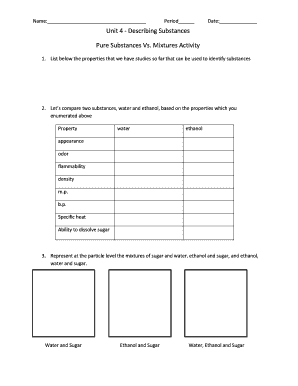Loading

Get Unit 4 - Describing Substances Pure Substances Vs. Mixtures Activity
How it works
-
Open form follow the instructions
-
Easily sign the form with your finger
-
Send filled & signed form or save
How to fill out the Unit 4 - Describing Substances Pure Substances Vs. Mixtures Activity online
This guide provides a clear, step-by-step approach to completing the Unit 4 - Describing Substances Pure Substances Vs. Mixtures Activity online. Designed to assist users of all experience levels, the guide ensures a thorough understanding of the document and its components.
Follow the steps to complete the activity successfully.
- Press the ‘Get Form’ button to obtain the document and access it in your preferred editing environment.
- Begin by filling in your name, period, and date at the top of the form. It is essential to provide this identifying information for organization and submission purposes.
- In section 1, list the properties studied that can be used to identify substances. This is an open-ended section where you summarize your observations and knowledge.
- Compare the properties of water and ethanol in section 2. Fill in the table with relevant information regarding each property, such as appearance, odor, flammability, density, melting point, boiling point, specific heat, and the ability to dissolve sugar.
- For section 3, use diagrams or sketches to represent the particle level of the mixtures of sugar with water, ethanol with sugar, and all three substances combined. This visual representation should clarify your understanding of the mixtures.
- In section 4, reflect on the properties of mixtures based on your previous experimental observations regarding the solubility of sugar in alcohol and water. Formulate a conclusion based on your findings.
- Section 5 requires you to predict the density of a 50-50 mixture of ethanol and water. Consider the properties you have noted to provide a thoughtful estimation.
- In section 6, gather density data from each group according to the assigned ratios. Fill in the table with the data collected, ensuring accuracy and completeness.
- Discuss how the collected data in section 7 supports your conclusions about the properties of mixtures. Relate your findings to the comparisons and predictions made in previous sections.
- For section 8, sketch the heating curve for the 50-50 mixture of water and ethanol. After conducting the experiment, provide an actual curve based on your observations.
- Sections 9 and 10 require you to explain methods for separating mixtures. Describe the process of separating sand and salt, as well as sulfur and iron, detailing each step clearly.
- Finally, provide definitions for a mixture and a pure substance in sections 11 and 12 to conclude your activity.
- After completing the form, review all entries for accuracy. You can then save changes, download, print, or share the document as needed.
Complete your activity online today for an enriching learning experience.
A pure substance is a form of matter that has a constant composition and properties that are constant throughout the sample. Mixtures are physical combinations of two or more elements and/or compounds. Mixtures can be classified as homogeneous or heterogeneous.
Industry-leading security and compliance
US Legal Forms protects your data by complying with industry-specific security standards.
-
In businnes since 199725+ years providing professional legal documents.
-
Accredited businessGuarantees that a business meets BBB accreditation standards in the US and Canada.
-
Secured by BraintreeValidated Level 1 PCI DSS compliant payment gateway that accepts most major credit and debit card brands from across the globe.


